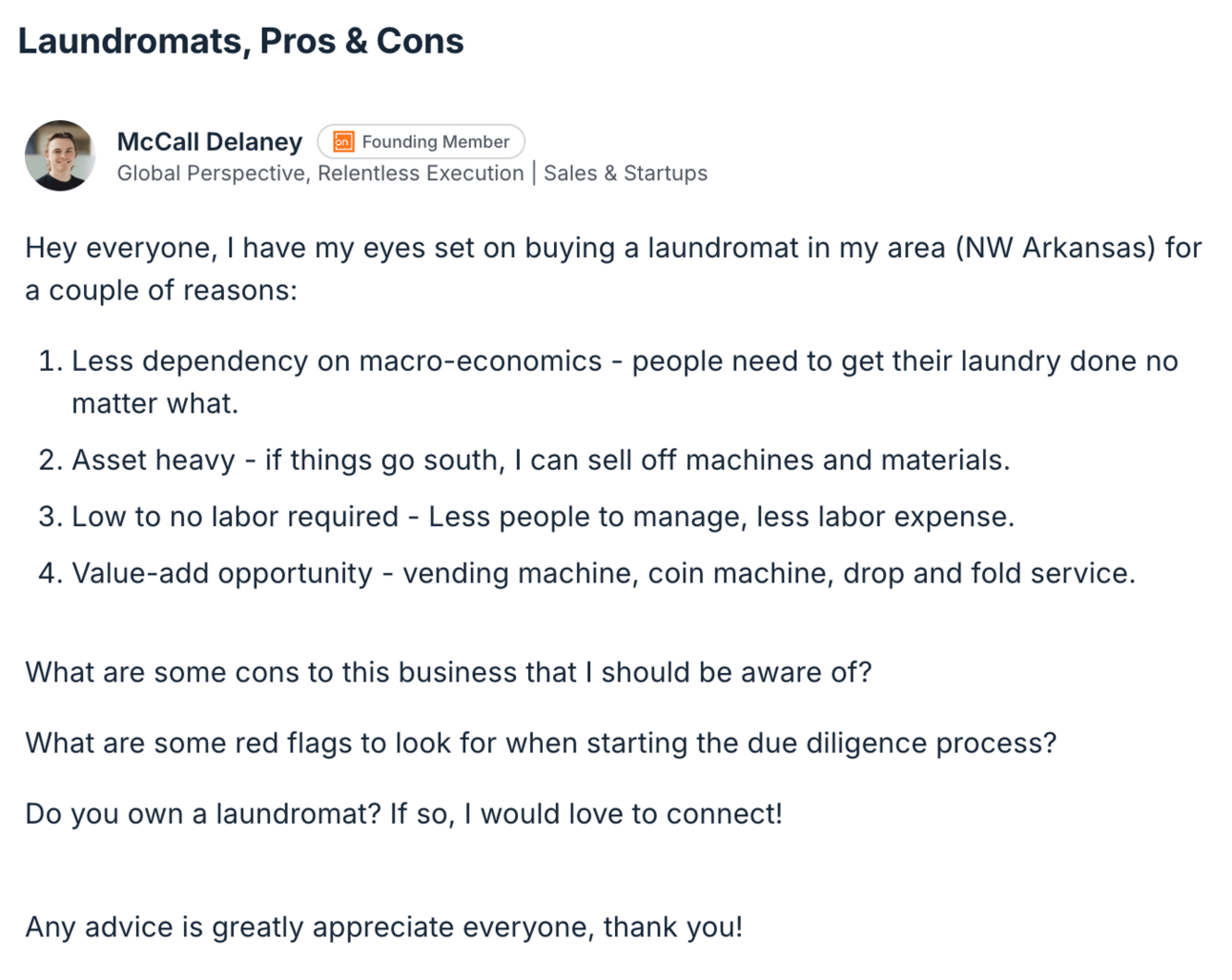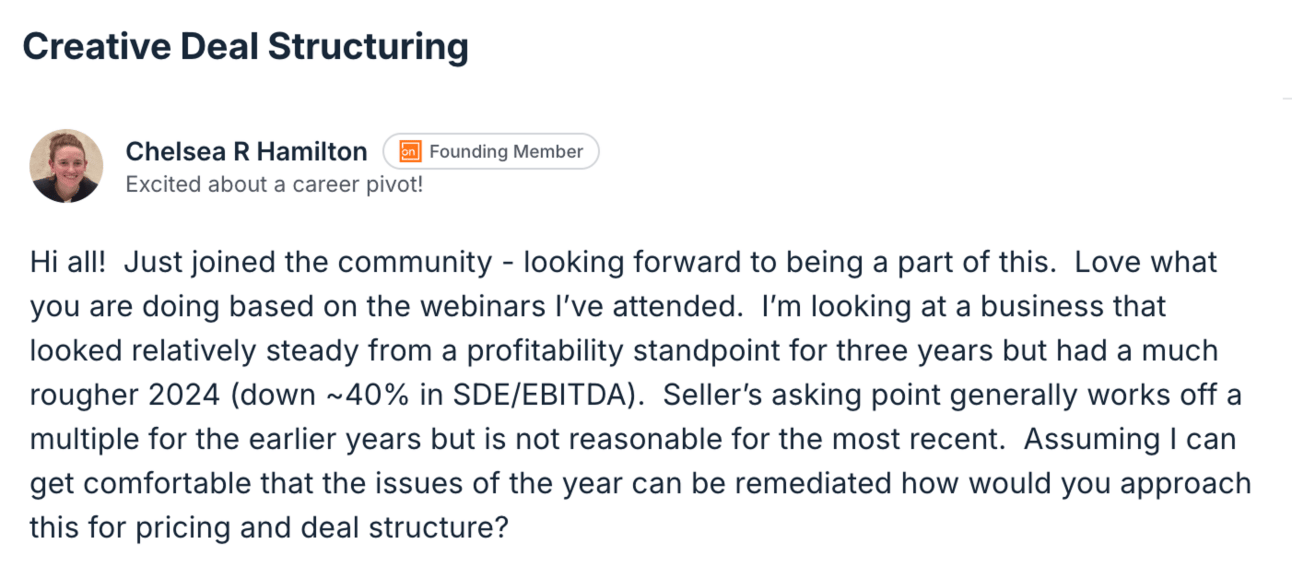- SMB Signal by Mainshares
- Posts
- 📡 SMB Signal: Niche manufacturing deals, SBA workshops and operating a termite business
📡 SMB Signal: Niche manufacturing deals, SBA workshops and operating a termite business
Plus, a deep dive into metal fabrication and creative ways to structure deals
Hello, and welcome to 📡 SMB Signal by Mainshares! Each week, we spotlight high-quality small business deals, operator insights, and tactical playbooks for buying, running, or investing in Main Street businesses. Join 8,000+ investors and operators staying sharp and deal-ready.
🔍 Deal watch
Looking to invest? Check out some of the latest SMB investment opportunities. 👉 Sign up on Mainshares to access live deal details.
1. High Margin Specialty Manufacturer
📈 Investment Opportunity
Location: California
Founded Year: 1994
Cash Flow: $8,694,868
LTM Revenue: $19,047,017
TLDR: A sponsor group is acquiring a 30-year-old specialty manufacturer known for its custom metal panels used in cold storage construction and indoor controlled environment agriculture. The company serves major clients like Costco and Trader Joe’s, positioning it as a leader in industries where insulation quality, longevity, and speed are critical.
Why is this interesting?
Sticky revenue. 75% of revenue comes from cold storage construction, with 25% from the rapidly growing CEA segment. This is a trusted supplier for large-scale, repeat clients in food processing, supermarkets, and cannabis cultivation.
Operational upside. The sponsor plans to modernize its sales function, diversify suppliers, and open a second production facility in Texas—strategies aimed at increasing capacity, reducing costs, and capturing new markets.
Leadership stability. The current owner will retire after a two-year transition period. Key management figures are committed to staying through the transition, incentivized by an equity earn-out over the next three years.
2. Critical Infrastructure Contracting Business
📈 Investment Opportunity
Location: California
Cash Flow: $5,237,504
LTM Revenue: $21,767,787
TLDR: This critical infrastructure contracting firm specializes in underground utility services for essential sectors like telecommunications, railroads, power, and EV charging. With $21.8M in sales and $5.2M EBITDA, the company has maintained steady financial performance through economic cycles and is positioned for aggressive expansion under new leadership.
Why is this interesting?
Strategic market position. The business has a proven track record across non-cyclical sectors like telecommunications and EV charging—markets projected to grow at CAGRs of 14.8% to 15.9% through 2030.
Operational upside. The new leadership plans to implement operational frameworks to streamline processes and expand into higher-margin services, positioning the company for significant growth while maintaining core service lines.
Seller confidence. The deal structure includes a 20% seller roll-over, aligning the seller’s interests with new ownership and reinforcing confidence in the company’s growth trajectory.
Looking to acquire? Here are a few standout small businesses actively seeking an operator to take the reins. If you’re actively searching, 👉 fill out your Buyer Profile to unlock deal flow—or email us to learn more about a specific opportunity.
3. Commercial Electrical Contractor
🔑Buyer Opportunity
Location: Oklahoma
Founded Year: 2005
Cash Flow: $1,596,042
LTM Revenue: $7,310,202
TLDR: The business is a 20-year-old commercial electrical contractor serving large-scale apartment and residential developers across the Midwest. The company brings in over $7.3MM in revenue with 95% coming from repeat corporate clients—despite no advertising or outside sales function. With $2MM in secured income already booked for 2025 and professional staff in place, this business is poised for scalable growth under a more focused owner.
Why is this interesting?
Recurring commercial work. 95% of revenue comes from a loyal, repeat client base in multifamily and residential development.
SBA pre-approved. The business is bankable and comes with a $1MM seller note for qualified buyers.
Staffed and scalable. 18 full-time employees and one manager run the day-to-day operations. Owner is partially absentee.
Growth tailwinds. Zero advertising or outbound sales today. Pipeline is based purely on reputation—yet $2MM+ of 2025 work is already secured.
4. Niche Industrial Equipment Manufacturer
🔑Buyer Opportunity
Location: NY
Founded Year: 2006 (with legacy dating to 1990s)
Cash Flow: $1,020,506
LTM Revenue: $1,846,023
TLDR: This niche manufacturer designs and builds high-efficiency melting, mixing, and filling equipment for industries ranging from candle and soap making to aerospace and cosmetics. Products are sold exclusively via two e-commerce platforms, supported by a lean team and no receivables (100% prepay). With proprietary technology, high margins (55%+ SDE), and global customers—including Fortune 500 companies—this asset-light business is ripe for scale.
Why is this interesting?
Asset-light, high-margin. With just 5–7 employees, this business produces $1MM+ SDE on <$2MM in revenue, with minimal overhead and zero receivables.
Proprietary product. PRIMO melting tanks are an industry standard for rapid, low-energy heating, offering 2–3x faster performance with 50% less electricity.
Global customer base. 30+ year history, e-commerce driven sales, and international reach with no contracts—just reliable recurring orders.
Untapped marketing. No social media or sales team. Growth potential lies in digital presence, trade show exposure, and channel partnerships.
🎥 Upcoming events

The SBA recently released significant SOP updates that will impact small business acquisitions financed through SBA loans. To help SMB investors and buyers navigate these changes, we’re hosting a workshop series to break down what’s new and how to adapt.
🗓️ Wednesday, May 14
👤Host: Brei Silvia, National Specialty Lending, Live Oak Bank
🕛 12 PM CT / 1 PM ET
👉Register now
🗓️ Thursday, May 22
👤Host: Ben Woodward, VP Senior Business Development Office, First Internet Bank
🕛 12 PM CT / 1 PM ET
👉Register now
🔑 Top questions asked this week
Every week, we pull real questions straight from the Mainshares community, where small business buyers, investors, and operators swap notes, deals, and advice in real time. Here are some of the top insights from the week.
1. How do you structure deals with outside investors?
A: From Will Fry, Mainshares
The standard approach is to sell those investors “participating preferred equity”. This means that they contribute to the down payment (and any additional equity you need). Their investment gets a minimum “preferred return” and then “participates” with you in future distributions once they get their initial investment back.
For easy numbers, let’s say you’re buying a $1M business and raise $100K of equity from 1 investor. You give that investor a 10% preferred return and a 2.0x step up (will explain this below).
At the end of the 1st year, your investor has $100K in the business and you owe him 10% on top. Let’s say you have $50K to distribute. What happens?
1. Pay down any of the preferred return ($100K invested * 10% preferred return = $10K to the investor, $40K left over)
2. Pay back his initial investment ($100K invested, so the rest of the $40K goes to him)
3. Split the profits ($0)
Now, he still has $60K invested in.
At the end of the 2nd year, let’s say you have $75K to distribute. What happens?
1. Pay down any accrued preferred return ($60K invested x 10% = $6K to the investor, $69K left)
2. Pay back his initial investment ($60K invested, so $60K of the $69K goes to finishing repaying his investment, $9K left)
3. Split the profits ($7.2K to you, $1.8K to him)
At the end of the 3rd year, let’s say you have $50K to distribute. What happens?
1. Pay down any accrued preferred return ($0K invested x 10% = $0, so all $50K left)
2. Pay back his initial investment ($0K invested, so all $50K left)
3. Split the profits ($40K to you, $10K to him)
A few notes:
If you put any $$ down, it’s treated the same as an investor
The profit split in Step 3 is calculated by taking the initial investment % multiplied by the step-up. Because he put in 10% of the deal and you offered a 2.0x step-up, he gets 20% of profits.
The 3 steps are referred to as the “waterfall”
You need investors to own less than 20% after the “step-up” or they’ll need to PG the loan too!
2. What should you look for in a laundromat due diligence?
A: From Marco White, Buy With Mainshares
I think there’s a few things you want to consider here when evaluating a deal like this:
Equipment—Your machines make or break a business like this. How old are they? What is the maintenance schedule / costs? When will they need to be replaced? Are they owned or lease?
Lease—Location is super important on a business like this. How long is the lease? Are there options to renew? What’s the relationship like with the landlord?
Cash Business—Many laundromats are cash only, making revenue hard to prove. Do you have a bank that will lend to this? Ensure all income is verifiable and not inflated for the sale.
Utilities—These bills are pretty closely tied to revenue. Ensure they line up or seller could be inflating revenue.
3. How would you structure a deal with declining earnings?
A: From Nate Faygenholtz, Community Member
Hi Chelsea! The answer will depend on your own risk tolerance but here are some ways I might approach it if I was in your shoes:
Do the valuation off a weighted average and emphasis on 2024 and TTM, then plan to pull monthly P&Ls once you get access to QuickBooks (or similar).
Put a contingent seller note (my preference would be on full standby) with some hurdle for forgiveness so you have some additional time to validate and mitigate risk if it repeats itself.
Now, I've found "that downturn is behind us and we're poised for success" is, unfortunately, not an uncommon story so I may trust the seller’s at face value but will immediately drill into historical customer concentration (that 40% may have been 1 or 2 key customers) or go on other tangents to find the real root cause offline. You may also want to do some research to see if there may have been macro-economic factors in play - an example would be if some % of revenue is tied to new construction, which has had some slowdown in the past year.
My POV on these type of deals is if you're going to "trust but verify" you should also be very honest with yourself on what needs to be true for this transaction to work and make sure you do your own round of financial diligence to validate those truths before you pay a vendor. Hopefully this helps; good luck!
🔁 ICYMI
Industry Deep Dive: A Guide to Acquiring a Metal Fabrication Company (Industry Report)
New SBA SOP Rules: What Investors Need to Know (Article)
The Real Work-Life Balance: Boundaries That Actually Hold (Video)
Raoul Kouamou successfully acquires a four-decade-old water and sewer systems assessment firm (Case Study)
🎙️ Latest podcast episode
Turn insights into action
Join 1,000+ investors and operators backing the next generation of small businesses on Mainshares. Discover deals, raise capital, and build with a community that’s in the trenches.


